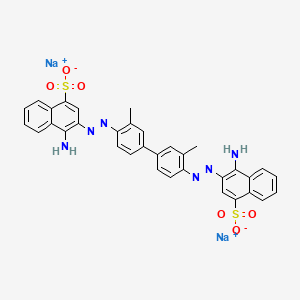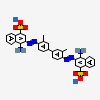C.I. Direct Red 2
- 992-59-6
- Benzopurpurine 4B
- C.I. Direct Red 2
- DIRECT RED 2
- Benzopurpurin 4B
- Create:2005-07-19
- Modify:2025-01-11

- benzopurpurine 4B
- C.I. direct red 2
- direct red 2
- 992-59-6
- Benzopurpurine 4B
- C.I. Direct Red 2
- DIRECT RED 2
- Benzopurpurin 4B
- Diaphtamine Purpurine 4B
- Paper Red 4B
- Azamin 4B
- Eclipse Red
- C.I. 23500
- Purpurine 4B
- Purpurin 4B
- Diphenyl Red 4B
- Hispamin Red 4B
- Direct Red DCB
- Azocard Red 4B
- Diazine Red 4B
- Benzopurpurine 4BX
- Cotton Red 4B
- Diphenyl Red 4BS
- Direct Red 4A
- Direct Red 4B
- Erie Benzo 4BP
- Bencidal purple 4B
- Calcomine Red 4BX
- Paper Red 4BS
- Benzopurpurine 4BKX
- Brasilamina Red 4B
- Erie Red 4B
- Amanil purpurine 4B
- Diazol Purpurine 4B
- Direct Purpurine 4B
- Tertrodirect Red 4B
- Diamine purpurine 4B
- C.I. Direct Red 2, disodium salt
- Atul Direct Red 4B
- Benzanil purpurine 4B
- Direct Purpurine M4B
- Diazamine purpurine 4B
- Phenamine Purpurine 4B
- Chrome Leather Red 4B
- Kayaku Benzopurpurine 4B
- Mitsui Benzopurpurine 4BX
- Diacotton benzopurpurine 4B
- Ditolybis(azonaphthionic acid)
- Benzopurpurine 4B ,
- G519JHX5MJ
- C.I. Direct Red 2 disodium salt
- DTXSID3025203
- MFCD00012410
- Amanil purpurine
- Disodium 3,3'-(3,3'-dimethyl(1,1'-biphenyl)-4,4'-diyl)bis(azo)bis(4-aminonaphthalene-1-sulphonate)
- disodium;4-amino-3-[[4-[4-[(1-amino-4-sulfonatonaphthalen-2-yl)diazenyl]-3-methylphenyl]-2-methylphenyl]diazenyl]naphthalene-1-sulfonate
- Diaphtamine purpurine
- Tetrodirect Red 4B
- Benzopurpurine 4B (Technical Grade)
- Cerven prima 2 [Czech]
- Brasilamina Red 4B; C.I. 23500; Calcomine Red 4BX; Chrome Leather Red 4B
- Cerven prima 2
- CCRIS 690
- Ditolylbis(azonaphthionic acid)
- NSC-5015
- BENZOPURPURIN B
- HSDB 4226
- NSC 5015
- EINECS 213-594-3
- UNII-G519JHX5MJ
- AI3-62957
- Disodium o-tolidinediazobis(1-naphthylamine-4-sulfonate)
- SULTAN RED 4B
- CI DIRECT RED 2
- disodium 4-amino-3-((E)-{4'-[(E)-(1-amino-4-sulfonato-2-naphthyl)diazenyl]-3,3'-dimethyl[1,1'-biphenyl]-4-yl}diazenyl)-1-naphthalenesulfonate
- 1-Naphthalenesulfonic acid, 3,3'-((3,3'-dimethyl(1,1'-diphenyl)-4,4'-diyl)bis(azo))bis(4-amino-, disodium salt
- DTXCID105203
- SCHEMBL1897261
- BENZOPURPURINE 4B [MI]
- CHEMBL1471289
- SUXCALIDMIIJCK-UHFFFAOYSA-L
- Tox21_202508
- C.I. DIRECT RED 2 [HSDB]
- Direct red 2 (C.I. 23500)
- AKOS000282537
- NCGC00091339-01
- NCGC00260057-01
- 1-Naphthalenesulfonic acid, 3,3'-((3,3'-dimethyl(1,1'-biphenyl)-4,4'-diyl)bis(azo))bis(4-amino-, disodium salt
- CAS-992-59-6
- B0781
- NS00043054
- D88688
- Q818516
- 1-Naphthalenesulfonic acid, 3,3'-((3,3'-dimethyl(1,1'-biphenyl)-4,4'-diyl)bis(2,1-diazenediyl))bis(4-amino-, sodium salt (1:2)
- 3,3'-((3,3'-DIMETHYL(1,1'-BIPHENYL)-4,4'-DIYL)BIS(2,1-DIAZENEDIYL))BIS(4-AMINO-1-NAPHTHALENESULFONIC ACID) SODIUM SALT (1:2)
- sodium 3,3'-(1E,1'E)-(3,3'-dimethylbiphenyl-4,4'-diyl)bis(diazene-2,1-diyl)bis(4-aminonaphthalene-1-sulfonate)
Pulp and Paper Processing [Category: Industry]
Leather Tanning and Processing [Category: Industry]
Textiles (Printing, Dyeing, or Finishing) [Category: Industry]

P203, P280, P318, P405, and P501
(The corresponding statement to each P-code can be found at the GHS Classification page.)
Aggregated GHS information provided per 41 reports by companies from 3 notifications to the ECHA C&L Inventory.
Information may vary between notifications depending on impurities, additives, and other factors. The percentage value in parenthesis indicates the notified classification ratio from companies that provide hazard codes. Only hazard codes with percentage values above 10% are shown.
EYES: First check the victim for contact lenses and remove if present. Flush victim's eyes with water or normal saline solution for 20 to 30 minutes while simultaneously calling a hospital or poison control center. Do not put any ointments, oils, or medication in the victim's eyes without specific instructions from a physician. IMMEDIATELY transport the victim after flushing eyes to a hospital even if no symptoms (such as redness or irritation) develop.
SKIN: IMMEDIATELY flood affected skin with water while removing and isolating all contaminated clothing. Gently wash all affected skin areas thoroughly with soap and water. If symptoms such as redness or irritation develop, IMMEDIATELY call a physician and be prepared to transport the victim to a hospital for treatment.
INHALATION: IMMEDIATELY leave the contaminated area; take deep breaths of fresh air. If symptoms (such as wheezing, coughing, shortness of breath, or burning in the mouth, throat, or chest) develop, call a physician and be prepared to transport the victim to a hospital. Provide proper respiratory protection to rescuers entering an unknown atmosphere. Whenever possible, Self-Contained Breathing Apparatus (SCBA) should be used; if not available, use a level of protection greater than or equal to that advised under Protective Clothing.
INGESTION: DO NOT INDUCE VOMITING. If the victim is conscious and not convulsing, give 1 or 2 glasses of water to dilute the chemical and IMMEDIATELY call a hospital or poison control center. Be prepared to transport the victim to a hospital if advised by a physician. If the victim is convulsing or unconscious, do not give anything by mouth, ensure that the victim's airway is open and lay the victim on his/her side with the head lower than the body. DO NOT INDUCE VOMITING. IMMEDIATELY transport the victim to a hospital. (NTP, 1992)
SMALL SPILLS AND LEAKAGE: If you spill this chemical, dampen the solid spill material with 5% ammonium hydroxide, then transfer the dampened material to a suitable container. Use absorbent paper dampened with 5% ammonium hydroxide to pick up any remaining material. Your contaminated clothing and the absorbent paper should be sealed in a vapor-tight plastic bag for eventual disposal. Wash all contaminated surfaces with 5% ammonium hydroxide followed by washing with a soap and water solution. Do not reenter the contaminated area until the Safety Officer (or other responsible person) has verified that the area has been properly cleaned.
STORAGE PRECAUTIONS: You should store this material under ambient temperatures. (NTP, 1992)
Patents are available for this chemical structure:
https://patentscope.wipo.int/search/en/result.jsf?inchikey=SUXCALIDMIIJCK-DVDDBBOFSA-L
- CAMEO ChemicalsLICENSECAMEO Chemicals and all other CAMEO products are available at no charge to those organizations and individuals (recipients) responsible for the safe handling of chemicals. However, some of the chemical data itself is subject to the copyright restrictions of the companies or organizations that provided the data.https://cameochemicals.noaa.gov/help/reference/terms_and_conditions.htm?d_f=falseDIRECT RED 2https://cameochemicals.noaa.gov/chemical/20305CAMEO Chemical Reactivity Classificationhttps://cameochemicals.noaa.gov/browse/react
- ChemIDplusChemIDplus Chemical Information Classificationhttps://pubchem.ncbi.nlm.nih.gov/source/ChemIDplus
- EPA Chemicals under the TSCA1-Naphthalenesulfonic acid, 3,3'-[(3,3'-dimethyl[1,1'-biphenyl]-4,4'-diyl)bis(2,1-diazenediyl)]bis[4-amino-, sodium salt (1:2)https://www.epa.gov/chemicals-under-tscaEPA TSCA Classificationhttps://www.epa.gov/tsca-inventory
- EPA DSSToxC.I. Direct Red 2https://comptox.epa.gov/dashboard/DTXSID3025203CompTox Chemicals Dashboard Chemical Listshttps://comptox.epa.gov/dashboard/chemical-lists/
- European Chemicals Agency (ECHA)LICENSEUse of the information, documents and data from the ECHA website is subject to the terms and conditions of this Legal Notice, and subject to other binding limitations provided for under applicable law, the information, documents and data made available on the ECHA website may be reproduced, distributed and/or used, totally or in part, for non-commercial purposes provided that ECHA is acknowledged as the source: "Source: European Chemicals Agency, http://echa.europa.eu/". Such acknowledgement must be included in each copy of the material. ECHA permits and encourages organisations and individuals to create links to the ECHA website under the following cumulative conditions: Links can only be made to webpages that provide a link to the Legal Notice page.https://echa.europa.eu/web/guest/legal-noticeDisodium 3,3'-((3,3'-dimethyl(1,1'-biphenyl)-4,4'-diyl)bis(azo)bis(4-aminonaphthalene-1-sulphonate)https://echa.europa.eu/substance-information/-/substanceinfo/100.012.359Disodium 3,3'-((3,3'-dimethyl(1,1'-biphenyl)-4,4'-diyl)bis(azo)bis(4-aminonaphthalene-1-sulphonate) (EC: 213-594-3)https://echa.europa.eu/information-on-chemicals/cl-inventory-database/-/discli/details/71121
- FDA Global Substance Registration System (GSRS)LICENSEUnless otherwise noted, the contents of the FDA website (www.fda.gov), both text and graphics, are not copyrighted. They are in the public domain and may be republished, reprinted and otherwise used freely by anyone without the need to obtain permission from FDA. Credit to the U.S. Food and Drug Administration as the source is appreciated but not required.https://www.fda.gov/about-fda/about-website/website-policies#linking
- Hazardous Substances Data Bank (HSDB)C.I. DIRECT RED 2https://pubchem.ncbi.nlm.nih.gov/source/hsdb/4226
- Haz-Map, Information on Hazardous Chemicals and Occupational DiseasesLICENSECopyright (c) 2022 Haz-Map(R). All rights reserved. Unless otherwise indicated, all materials from Haz-Map are copyrighted by Haz-Map(R). No part of these materials, either text or image may be used for any purpose other than for personal use. Therefore, reproduction, modification, storage in a retrieval system or retransmission, in any form or by any means, electronic, mechanical or otherwise, for reasons other than personal use, is strictly prohibited without prior written permission.https://haz-map.com/AboutC.I. Direct Red 2https://haz-map.com/Agents/4085
- ChEMBLLICENSEAccess to the web interface of ChEMBL is made under the EBI's Terms of Use (http://www.ebi.ac.uk/Information/termsofuse.html). The ChEMBL data is made available on a Creative Commons Attribution-Share Alike 3.0 Unported License (http://creativecommons.org/licenses/by-sa/3.0/).http://www.ebi.ac.uk/Information/termsofuse.html
- Japan Chemical Substance Dictionary (Nikkaji)
- NIOSH Manual of Analytical MethodsLICENSEThe information provided using CDC Web site is only intended to be general summary information to the public. It is not intended to take the place of either the written law or regulations.https://www.cdc.gov/Other/disclaimer.html
- NORMAN Suspect List ExchangeLICENSEData: CC-BY 4.0; Code (hosted by ECI, LCSB): Artistic-2.0https://creativecommons.org/licenses/by/4.0/C.I. Direct Red 2NORMAN Suspect List Exchange Classificationhttps://www.norman-network.com/nds/SLE/
- Springer Nature
- Wikidatabenzopurpurine 4Bhttps://www.wikidata.org/wiki/Q818516
- PubChem
- Medical Subject Headings (MeSH)LICENSEWorks produced by the U.S. government are not subject to copyright protection in the United States. Any such works found on National Library of Medicine (NLM) Web sites may be freely used or reproduced without permission in the U.S.https://www.nlm.nih.gov/copyright.htmlbenzopurpurine 4Bhttps://www.ncbi.nlm.nih.gov/mesh/67007060
- GHS Classification (UNECE)GHS Classification Treehttp://www.unece.org/trans/danger/publi/ghs/ghs_welcome_e.html
- EPA Substance Registry ServicesEPA SRS List Classificationhttps://sor.epa.gov/sor_internet/registry/substreg/LandingPage.do
- MolGenieMolGenie Organic Chemistry Ontologyhttps://github.com/MolGenie/ontology/
- PATENTSCOPE (WIPO)SID 388417229https://pubchem.ncbi.nlm.nih.gov/substance/388417229


 CID 13817 (Fast Scarlet)
CID 13817 (Fast Scarlet) CID 5360545 (Sodium)
CID 5360545 (Sodium)